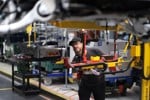Poor posture while staff are behind the wheel of a car will cost your business time and money.
The scale of back pain suffering in the UK is massive, with one in six working days lost due to the condition. Factor that number out across every worker in the country and the cost to UK plc is 4.9 million working days lost per year, according to figures from the Health and Safety Executive. This means lost productivity and potentially lost business because staff aren’t available to get to meetings.
According to Didcot-based Etcom People Engineers, a consultancy which works with companies to reduce the problem among company car drivers, there has been a rapid rise in clients suffering from back, neck or shoulder pain exacerbated by long hours spent at the wheel in poorly-adjusted seats.
According to Mannie Babington Smith, a physiotherapist with the company, common faults include not sitting back squarely in the seat and slumped shoulders and chest.
She claims that for around two-thirds of sufferers, the problem can be solved without physiotherapy but simply by drivers being assessed behind the wheel to acheive the correct posture.
She said: ‘Although some people are given guidance when choosing cars, very rarely are they given it from the standpoint of adopting best practice in posture.
‘I would like to see fleet managers issue posture training at the wheel as part and parcel of their health and safety regime, knowing that at the end of the line it may well result in improved productivity and bottom line.’

Incorrect: the shoulders and chest are slumped and the driver’s bottom is not tucked into the back of the seat. The driver is also too close to the steering wheel

Correct: the shoulder blades are touching the back of the seat, the chest is upright and the bottom is tucked into the back of the seat. Also a better distance from the wheel
Top 10 posture tips
1. The lower chest should come forward and up in order to relax the shoulder blades back and down
2. Shoulder blades should be in good contact with the back of the seat. The lower spine should not push into the back support.
3. The back of the head should be one finger’s thickness away from the headrest
4. Hands should be in the ‘ten-to-two’ position
5. The steering wheel should be directly in front of the driver and the driver’s wrist should be able to rest on top of the wheel
6. Avoid headrests which push the head forward
7. Choose a car without a lip at the back of the boot so equipment doesn’t have to be lifted over it
8. Drivers should not twist round to grab something from the back seat – stop and get out of the car
9. If drivers have a laptop or anything heavy on the passenger seat they should not haul it over to them: they should go round to the passenger door to get it
10. Men should not have a wallet in the back pocket as this twists the pelvis and can cause severe pain.
(Source: Etcom People Engineers)















Login to comment
Comments
No comments have been made yet.